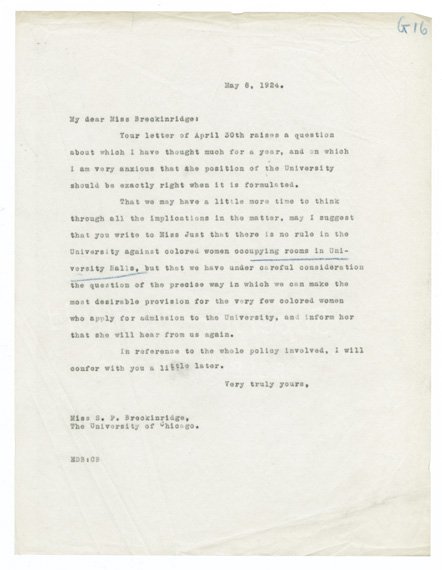The Social Question - Round Two
The decade of the 1920s brought a decisive shift in the level of integration on the University of Chicago campus. Whereas President Harry Pratt Judson had resisted social integration, the new President, Ernest DeWitt Burton, who took office in 1923, initiated broader consideration of the question, soliciting advice from colleagues at other institutions and also from his daughter, who worked for the Y. W. C. A.
Under Burton's leadership, the University administration addressed the issue of social integration self-consciously; committees were formed to develop a policy on housing. The result was a decision to admit African Americans to the dormitories.
The environment must also have improved more generally as a result of Burton's leadership. By the late 1920s we can find as many as nine African American students in a single yearbook and we see these students now participating alongside white students in the life of the institution, for instance in extra-curricular activities like the Spanish Club and the Women's Basketball Team.
The 1920s also saw the formation of a club called the "Interracial Group."

Typewritten letter, April 5, 1923
University of Chicago. Office of the President. Harper, Judson and Burton Administrations
In this interesting letter Wallace Heckman, the University Counsel, reports on efforts to understand the legal basis for supporting or resisting social integration. He describes a survey of Lincoln’s writings as leading to cautiousness about social integration.

Typewritten letter, May 8, 1924
University of Chicago. Office of the President. Harper, Judson and Burton Administrations
Here President Burton acknowledges Miss Breckenridge’s leading role in forcing the question of social integration, a role she had adopted first in 1907 when the question of Miss Georgiana Simpson’s residence in Green Hall had arisen.
Chicago: University of Chicago, 1928
Campus Publications Collection
This yearbook photo of Samuella G. Carver should be contrasted with that of Monroe Nathan Work in Case 9. Miss Carver participated in many extra-curricular activities, which earlier African Americans studying at the University of Chicago did not do.

